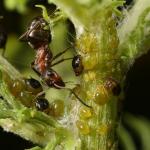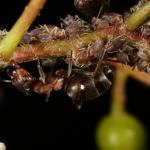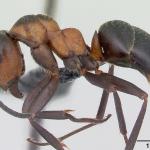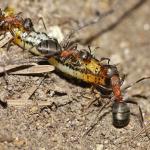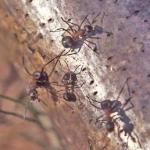Formica lugubris, F. aquilonia, F. rufa and F. pratensis comprise a group of morphologically similar British species which are commonly referred to as 'wood ants'. Only F. lugubris and F. aquilonia are recorded from both Britain and Ireland, whilst F. pratensis is now presumed to be extinct on the mainland, but remains in the Channel Islands. The nomenclature of these species, and the morphological distinctions between them, have been considered by Yarrow (1955).
F. lugubris is found as far south as Derbyshire and Radnorshire. Its range therefore overlaps with that of F. rufa in northern Britain and north Wales, and with that of F. aquilonia in Scotland (Edwards 1997 and in prep.). Elsewhere, F. lugubris is recorded from European mountains, extending from the Pyrenees through Eurosiberia to Kamchatka and Japan, and from northern Norway to Italy (Collingwood 1979).
Neither Shirt (1987) nor Falk (1991) list F. lugubris as scarce or threatened in Britain. The paucity of recent records from northern England and Wales no doubt reflects under-recording, although some Yorkshire and Derbyshire sites have been lost through over-shading, woodland clearance and urban growth (Collingwood & Hughes 1987, E. Langner pers. comm.). The ant has also disappeared from some Irish sites (Collingwood 1958, Breen 1977).
Formica lugubris colonises deciduous and coniferous woodland, and can extend into open areas, away from trees, which may be quite wet. It spreads more readily into new plantation areas than other British wood ants, and its upland occurrence on broken, rocky ground which supports only a sparse tree or shrub layer, demonstrates its tolerance of exposed conditions (Bolton & Collingwood 1975, Hughes 1975).
Mating flights occur in June and July.
The mound nests are composed of vegetable litter. Some exist in isolation, but large groups of interconnecting nests often occur, and may contain many hundreds of queens. Formica lugubris spreads by colony budding and, less frequently, by temporary social parasitism. In the second case, a fertile F. lugubris queen is adopted into a nest of F. lemani and, after elimination of the F. lemani queen, becomes the exclusive egg-layer. As the host workers die off, they leave only the F. lugubris queen and her progeny. In common with other wood ants, F. lugubris nests support many myrmecophilous arthropods, especially beetles, and including the ant Formicoxenus nitidulus.
Foraging workers follow pheromone trails from the nest mound. These trails can persist for months and may lead to good nectar sites or to groups of aphids from which the ants collect honeydew and the aphids themselves. Workers are also effective predators of other arthropods, including forest insect pests living in the tree canopy, and can have a considerable impact on their populations.
2002


